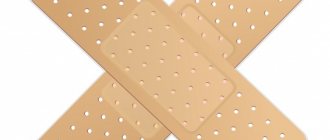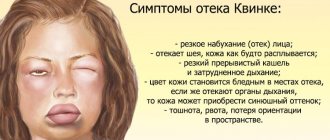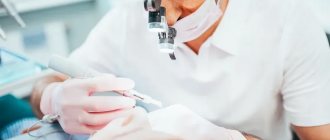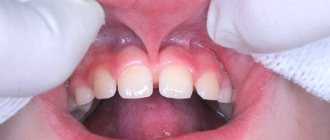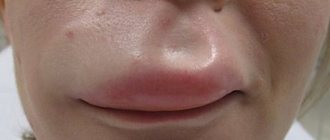A lip bruise is damage to soft tissues and subcutaneous capillaries as a result of exposure to various factors. This causes swelling, hematoma and swelling of the lips. Bruises do not pose a serious health risk.
Rather, it causes external discomfort, a feeling of unattractiveness, as well as discomfort while eating and talking. In such a situation, the most important thing is not to delay and start treatment as soon as possible so that the tumor does not spread to the face.
- The most common causes of hematomas and swelling of the lips
- Bruised lip: symptom manifestation
- Additional symptoms of bruising include:
- Bruised lip: first aid
- Bruised lip: medicines and folk remedies
- Remedies that are available in every home will also help with bruising of the lower and upper lip and the appearance of a bruise:
Common causes of hematoma and swelling of the lips
If the lip is bruised with swelling, it causes bleeding and further accumulation of blood as a result of ruptured blood vessels. This is how a hematoma forms. There may be several reasons before an injury:
- fall or blow;
- Inflammation after visiting a dentist or cosmetologist;
- operation;
- biting, cutting, cutting;
- sports injuries.
Bruises of the upper and lower lips most often occur in young children. They cannot sit still and get injured during active games. Athletes involved in sports such as boxing, gymnastics, football, basketball, etc. are also susceptible to bruising.
Laceration
Distinctive features of lacerated wounds are patchy edges of irregular shape, significant tissue damage in the walls of the wound channel, tissue detachment, and areas of skin scalping. The formation of a tissue defect due to their complete separation is possible. The depth of the wound channel is, as a rule, insignificant, while the affected area can reach large sizes in length and width. Bleeding is less than with cut wounds. Fabrics are often heavily contaminated, which is facilitated by the mechanism of injury: damage from dirty garden tools, falling from a bicycle or motorcycle onto asphalt or gravel, falling onto pieces of coal when working in a mine, etc.
Types of lacerations include crushed, bruised and scalped injuries. With crushed and bruised wounds, extensive destruction and necrosis of tissue is observed. Scalp wounds are characterized by partial or complete separation of the skin from the underlying tissue without significant destruction. Scalped injuries to the scalp can occur when hair gets into moving mechanisms, scalped wounds of the lower and upper extremities - when they get under the wheels of a vehicle or into rotating mechanisms. Injuries caused by contact with moving mechanisms can also cause open fractures and traumatic amputations.
Due to the large area of damage and tissue necrosis, lacerated wounds heal worse and fester more often than incised wounds. Healing by secondary intention or under a scab is typical. Healing by primary intention is possible in favorable circumstances: with a small amount of damage, a relatively small area of necrosis, the absence of gross defects of the skin and soft tissues, minor microbial contamination and a good state of the immune system.
Infection in lacerated wounds develops faster than in stab or cut wounds. The first signs of infection (swelling, hyperemia of the edges, sanguineous or mucous discharge) can be detected within a few hours after the injury, while in incised wounds the infection usually develops about a day after the injury. This necessitates early seeking medical help and further worsens the prognosis.
The wound process occurs in three stages. At the inflammation stage, necrotic tissue is destroyed and removed from the wound along with pus. Initially, the surrounding tissues swell, the lumen of the canal narrows or disappears, and blood clots and dead areas are “squeezed out” out. Then the inflammation becomes purulent. The remaining dead tissue is melted. A demarcation shaft is formed around the damaged area, separating necrotic tissue from healthy tissue.
After complete cleansing, the regeneration (recovery) phase begins, during which granulation tissue forms on the canal walls. Granulations gradually fill the entire defect and become denser. Then comes the epithelization phase, ending with the formation of a scar. With extensive soft tissue defects, independent healing becomes impossible; granulations have to be closed using skin grafting. The duration of each healing phase depends on the size of the damage, the degree of bacterial contamination, the amount of necrotic tissue, the presence of other traumatic injuries and somatic diseases, etc.
Lip bruise: symptoms
The main symptoms of a bruised lip are pain, bruising and swelling, and bruising may also appear. Symptoms appear quickly, literally against the background of changes in the lips.
There is a thickening on the inside of the lip at the site of the injury. Its size depends on the force of the blow, the amount of blood spilled, the victim’s blood pressure, the degree of coagulation and elasticity of the tissues.
Additional signs of injury include:
- it hurts to open your mouth;
- the appearance of watery blisters, ulcers and pustules at the site of injury;
- coating of lips with cracks;
- deterioration of general health, apathy, drowsiness;
- chills and increased body temperature up to 38 degrees;
- Itchy eyes and runny nose.
Severe inflammation and compaction can cause severe pain, increased swelling and an increase in temperature up to 40 degrees.
Lacerated wound of the lip: main stages of treatment
A lacerated wound on the lip from a blow or other minor mechanical damage can be treated at home using special wound-healing creams and ointments. If there is a discrepancy between the edges of more than 1 cm, suturing will be required, which is carried out by a doctor under sterile conditions.
Important: What to do if you get a razor cut?
Drug therapy
The healing time of a lip laceration depends on the degree of damage and the characteristics of the body’s regeneration. On average, the entire process takes 2-3 weeks. The following groups of medications will help speed up recovery and facilitate the entire process:
- 1. Complex analgesics – have a strong analgesic effect and help improve the general condition of the body.
- 2. Hemostatic drugs (Dicynon, Vikasol) - prescribed for heavy bleeding that does not stop for more than 1 hour. Help prevent large blood losses by activating the coagulation process.
- 3. Non-steroidal anti-inflammatory drugs (Ibuprofen) - reduce pain, eliminate swelling and swelling of the lip.
- 4. Wound healing ointments and creams - ointments based on zinc and heparin are used to treat wounds. You need to make sure that the medicine does not get on the oral mucosa, which can cause a burn.
Bruised lip: first aid
After a bruise, further treatment depends on the type of injury and the condition of the victim. However, there are general rules for first aid.
The first thing to do after an injury is to clean and disinfect the injury site, especially if there is a cut. You can use any antiseptic: Miramistin, Chlorhexidine.
Hydrogen peroxide is suitable for internal treatment; such manipulations will prevent infection from entering the open wound. Then they will apply something cold. Remember that you cannot use ice in its “pure” form.
Sudden and severe cooling can cause tissue necrosis and aggravate the situation. It is better to wrap ice cubes in a cloth and apply such a compress every 15 minutes. Visible results will appear after the first applications.
A child with an injury should see a doctor immediately. There may have been a head injury during the impact.
An injured child should see a doctor immediately.
Surgical intervention
A lacerated wound of the lip with separation of the edges requires sutures. The wound site is injected with a local anesthetic, after which the edges are sutured. The suture is treated with an antiseptic, after which a sterile bandage is applied.
Putting stitches on a lacerated lip wound
The suture site is examined daily for the presence of an inflammatory process. If the healing process is successful, the sutures can be removed on the 10th day. If there are large complex wounds and a large number of stitches, the assistance of a plastic surgeon may be required in the future.
After suturing, the patient is prescribed medications such as:
- 1. Antibiotics – prevent the development of the inflammatory process by destroying bacterial microflora in the body.
- 2. Analgesics - make the healing process less painful.
- 3. Non-steroidal anti-inflammatory drugs - reduce swelling and hyperemia of the skin.
After the sutures are removed, the wound is treated with an antiseptic without the need to apply a sterile dressing. To eliminate the development of the inflammatory process in the oral cavity, rinsing with decoctions of medicinal herbs, Furacilin, and treatment with hydrogen peroxide are prescribed.
It is strictly forbidden to apply stitches outside a medical facility. Even with experience, the likelihood of infection is high, since it is not possible to achieve sterility at home, as is possible in the operating room.
Bruised lip: medications and folk remedies
In the case of concussion, a visual examination of the patient is sufficient to assess the scale of the tragedy. Injuries that are not too serious can be treated at home. Ask your pharmacist and he will definitely advise you on effective measures. Daily manipulations include:
- constant treatment of the wound area with antiseptics;
- Washing the internal wound with a decoction of chamomile, propolis in water, sage;
- treating lips with Troxevasin ointment. The product relieves swelling, fights hematomas;
- The healing process will be accelerated by Badyaga gel;
- lotions with lead water. The product has an analgesic effect and solves the problem of swelling.
Badyaga gel - a remedy for bruises and bruises
Remedies that are available in every home will also help with bruising of the lower and upper lip and the appearance of a bruise:
- cabbage leaf A small piece is put on and sealed with plaster;
- A mixture of crushed aloe leaf and 1 tablespoon of honey. Apply to the sore spot for 15 minutes, then rinse your mouth thoroughly;
- black tea lotions. Dip the bag in a little hot water, take it out, squeeze it and apply it to the bruise for a few minutes;
- If it's summer outside, you need to find celandine. The juice of the grass is squeezed out. Periodically apply a cotton pad soaked in juice to the bruise;
- Potato starch is an excellent remedy for hematoma. It is diluted with water to form a paste and applied to the wound.
- Bright orange, milky celery juice accelerates the healing of bruises.
- The recovery process usually takes several days. If after 3-4 days the situation has not changed or worsened, consult a doctor immediately. They will assess the condition, help remove the hematoma and tell you how to reduce swelling after a bruise on the lip.
- What not to do if you have a bruised upper or lower lip
- In order not to aggravate the situation and cause even greater swelling on the lip, in no case should you take the following measures:
- Apply something warm to the bruise and also apply ointments with a warming effect. They dilate blood vessels, causing bruising;
- Use iodine or verdigris. These products may cause chemical burns to sensitive mouth skin;
- Use of cosmetics and decorative cosmetics. If these products come into contact with a wound, it will cause inflammation;
- Avoid foods that are too cold or too hot;
- prolonged exposure to the sun or frost.
If there is a strong blow and cut, the bruised wound may bleed. In this case, you will need to sew. You should not do such manipulations on your own - it is better to seek help from a doctor. What are the consequences after a bruised lip?
Although bruising and swelling of the lip are not serious in themselves, treating a bruised lip incorrectly or not treating it properly can lead to complications. The worst consequence of a bruised lip is infection, followed by pus deposits and blood poisoning. Deep trauma causes lip deformation, which requires surgery.

